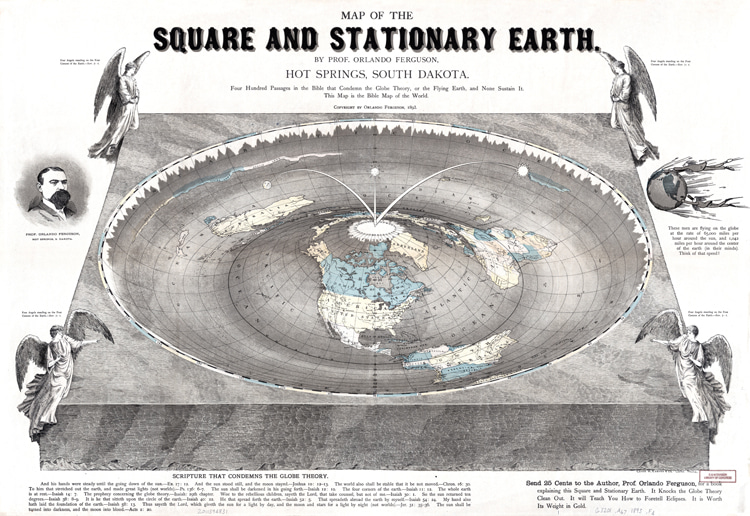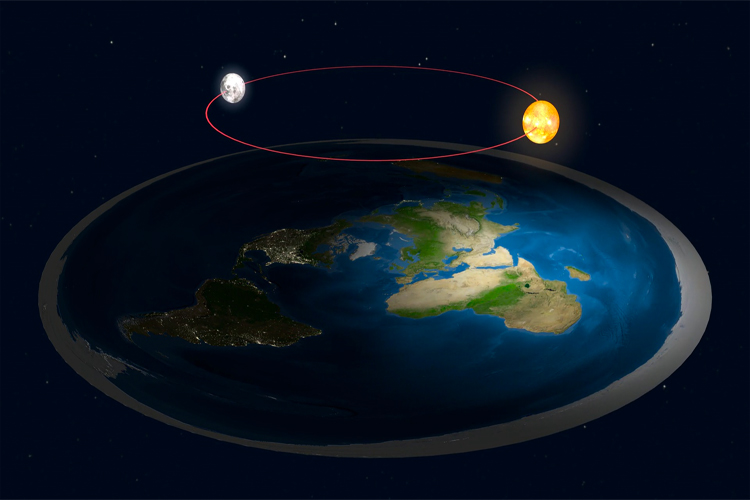Is Planet Earth an oblate spheroid or flat like a sheet of paper? The answer to this question isn't unanimous. Meet the Flat Earthers.
They're controversial and often made the laughingstock of the astronomical community.
The Flat Earth Society (FES) is a group of individuals who reject the widely accepted scientific understanding of our planet as a spherical object and instead advocate for the belief that the planet is flat.
Within this organization, previously known as the International Flat Earth Research Society, members share a range of unconventional theories and ideas that challenge established scientific principles.
These beliefs include the notion that the Blue Planet is a disc-shaped entity surrounded by a massive ice wall, with the Sun and Moon moving in circular paths above it.
Flat Earthers often dismiss gravity, relying on alternative explanations such as density and buoyancy to account for the observed behavior of objects.
Skepticism towards space exploration, the rejection of satellite imagery, and a suspicion of mainstream scientific institutions, particularly NASA, are common threads in their discourse.
Despite overwhelming evidence supporting a nearly spherical planet, the Flat Earth Society persists as a fringe community with a distinct set of beliefs that starkly contrast with the scientific consensus.

The Flat Earthers' 25 Main Beliefs
The Flat Earth Society has members all around the globe.
Here is a list of some common beliefs associated with the organization founded in 1956 by Samuel Shenton:
- Earth is Flat: The primary belief is that Terra is a flat, disc-shaped object rather than a spherical one;
- Flat Earth Model: Some members may adhere to specific flat Earth models, such as the Azimuthal Equidistant Projection or others, to explain the layout of continents and oceans on the flat Blue Planet;
- Ice Wall: Many Flat Earthers claim that Antarctica is not a continent but a giant ice wall encircling the flat Gaia, preventing water from falling off the edge;
- Gravity is a Hoax: Some members reject the concept of gravity as presented in mainstream science, proposing alternative explanations such as the Earth constantly accelerating upward;
- NASA Conspiracy: Flat Earthers often believe that space agencies, especially NASA, are engaged in a massive conspiracy to conceal the true nature of our planet;
- Photos and Videos are Faked: Members may argue that all space-related images and videos, including satellite imagery, are CGI or otherwise manipulated to maintain the illusion of a spherical Earth;
- Flight Paths and Navigation: Flat Earthers may question certain flight paths and navigation routes, arguing that they make more sense on a flat Earth model;
- Sun and Moon Movements: Belief that the Sun and the Moon move in a circular motion above the plane planet, creating day and night cycles;
- No Curvature: Flat Earthers often claim that the lack of observable curvature, especially over long distances, supports the idea of a flat Terra;
- Flat Horizon: The belief that the horizon always appears flat and the absence of a noticeable curve backs up the notion of a plane Gaia;
- No Outer Space: Some members reject the existence of outer space altogether, asserting that what is perceived as space is simply a dome or firmament above the plane Earth;
- Water's Level Surface: The idea that bodies of water always find a level surface, and this is inconsistent with the curvature expected on a spherical Earth;

- No Gravity, but Density and Buoyancy: Some Flat Earthers reject the concept of gravity and instead argue that objects fall or rise due to differences in density and buoyancy;
- Sun's Size and Distance: Belief that the Sun is much smaller and closer to the Earth than mainstream science suggests;
- No Space Travel: Flat Earthers may contend that space travel is impossible and that all claims of human space exploration are fabricated;
- Flight Altitudes: Questioning the altitude of high-flying airplanes and claiming that they should encounter different conditions if the Earth were a sphere;
- Flat Earth Maps: Advocacy for the use of alternative maps that depict a flat Earth, often featuring a circular or diamond shape;
- Eratosthenes Experiment Critique: Criticism of the ancient Eratosthenes experiment, which measured the Earth's circumference, arguing that it is flawed or misinterpreted;
- Perceived Lack of Curvature in Photos: Pointing to photographs taken from high altitudes and claiming that the lack of a visible curve is evidence of a flat Earth;
- Lunar Eclipse Explanation: Offering alternative explanations for lunar eclipses, suggesting that they are caused by unknown celestial bodies rather than the Earth's shadow;
- No Coriolis Effect: Denying the Coriolis effect and claiming that the lack of observable deflection in moving objects disproves the Earth's rotation;
- No Edge to Fall Off: Flat Earthers often argue that there is no edge to the flat Earth and that the concept of falling off the edge is a misrepresentation;
- Selective Acceptance of Science: Members may selectively accept or reject scientific principles based on whether they align with flat Earth beliefs;
- Religious Interpretations: Some Flat Earthers incorporate religious beliefs into their worldview, suggesting that scriptures or religious texts support a flat Earth cosmology;
- Personal Observation: Emphasizing personal observation and anecdotal evidence over scientific consensus, arguing that what one sees with their eyes is more reliable than scientific explanations;
